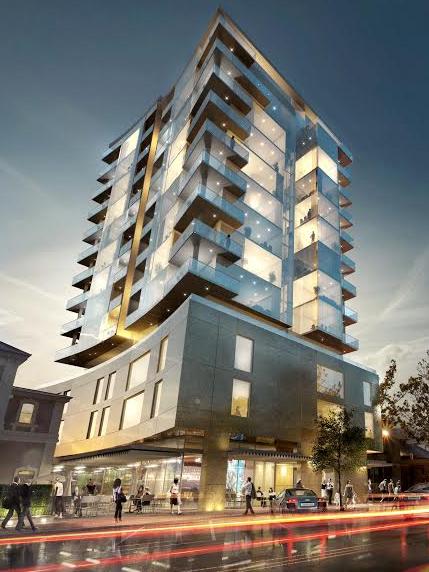The battle of heritage versus high-rise in our City of Churches
A NEW wave of tower apartments is reshaping Adelaide’s skyline. But what does it mean for the historic buildings that have long defined the City of Churches? Can heritage stand alongside high-rise?

City
Don't miss out on the headlines from City. Followed categories will be added to My News.
- Fury as aged-care provider project bypass council planning
- A new CBD building is drawing attention — for the wrong reasons
- Building height restrictions scrapped for key North Adelaide sites
- Heritage mansion restoration to begin, signalling $45m development
AT THE corner of South Tce and Hutt St, where the city meets the Parklands, a crew of cranes and builders are piecing together Adelaide’s newest high-rise.
The 13-storey Parkview Apartments will tower over the 1876-built mansion beneath it and every other cottage and cafe crammed into that corner of the CBD.
“Why do people want to live off Hutt St?” National Trust SA president Norman Etherington asks The City, craning his neck to better view the near-complete development.
“It is because it is a terrific neighbourhood, it has density because of the very small cottages and townhouses.

“If you build these (apartments) up and down the street, people will not want to live there anymore.”
Talk of Hutt St soon shifts to King William St, then to Victoria and Light squares, North Adelaide and Churchill Rd.
Each precinct, Etherington says, is its own architectural illustration of the uneasy union of old and new – of heritage and high-rise – that is increasingly defining Adelaide’s CBD and city fringe.
The friction is apparent in Joslin, where plans for an aged-care home of up to seven storeys has locals worried for the future of their quiet suburb.

It is with similar concerns that residents this month packed public meetings to voice concerns about the State Government’s plan to “spot-zone” sites around Adelaide – including in Malvern, Mile End and the old Caroma factory in Norwood – for high-rise housing.
The simmering tension exploded to the forefront of public debate when the State Government last year released a discussion paper proposing a radical overhaul of heritage protections.
The suggestion of allowing local heritage-listed buildings to be demolished “on merit” riled-up residents’ groups, angered councils and infuriated the National Trust amid fears it would trigger a “demolition derby” of the city’s sandstone soul.
The paper sparked renewed debate about the importance of Adelaide’s historic buildings, and whether they could live alongside – or even survive – the city’s apartment boom.
“This tension has always been there,” says Etherington.
“As soon as there was legislation, there was tension.”
The foundations of the debate were laid in the Don Dunstan era, when the reformist Labor Premier introduced the first laws to protect buildings of “heritage value to the state”.
The Dunstan government famously bought the now heritage-listed Edmund Wright House on King William St to save it from demolition and the Premier directly intervened to protect Ayers House from redevelopment.
But as SA slipped into economic decline in the 1980s, the preservation of heritage buildings took a back seat as then Labor leader John Bannon pursued a crane-led recovery of the state’s fortunes.
The government used the State Bank to stimulate numerous private developments – including the Myer Centre – which resulted in a steady loss of historic buildings.
Heritage politics split Adelaide City Council through the late 1980s and early 1990s, as pro-development and pro-heritage factions fought furiously for the power to define the city’s streetscapes.
The controversial demolition of Pirie St’s Aurora Hotel and the original House of Chow were flashpoints in the debate, sparking fierce public protests.
The back-and-forth led to the creation of Adelaide’s first local heritage register – the scheme Planning Minister John Rau is now looking to reform.
Of the more than 8000 properties on the register today, almost a quarter are dotted around the CBD.
Lord Mayor Martin Haese told a packed Town Hall meeting soon after the release of the discussion paper that “Adelaide cannot have a develop-at-all-cost mentality” and that “the line not to cross is the heritage line”.
Mr Haese says while the council will “vigorously strive to protect” heritage buildings, it is not anti-development.

“We believe development and heritage can coexist well with sensitive design and the re-use of older buildings,” he says. “A key target of the council’s strategic plan is to grow city residents to 30,000 by 2025 and providing people with quality apartments is a great way to help achieve this.
“This could be new buildings or readapting heritage buildings.”
Property Council SA executive director Daniel Gannon agrees, saying a “suturing” of old and new can breathe fresh life into Adelaide’s historic buildings.
“While our past should absolutely inform our future, we should not handcuff ourself when it comes to design,” Gannon says.
“By doing things like retaining facades and building up behind them, you can combine heritage with modern day residential and office offerings.”
On the city fringe, threats to overhaul the local heritage listing process were met with hostility from local councils adamant that they should retain the power to shape the character of their districts.
Norwood, Payneham & St Peters Council letterboxed almost 22,000 properties about the proposed changes, which it feared might result in “significant and irreversible” damage to the area.
Residents, too, voiced strong opposition to the discussion paper. St Peters Residents’ Association president David Cree says the heritage protection system “works very well” and there is no clear basis for reform.
North Adelaide Society committee member John Brigland has a more pointed opinion.
“John Rau is clearly no friend of heritage precincts such as North Adelaide,” says Brigland.
The man himself cleary, and quite emphatically, disagrees.
Mr Rau says the notion he is out to “bulldoze heritage buildings on your street” is “fantasy world stuff”, circulated by people who either have not read the discussion paper or are hellbent on “frightening or disturbing” people.
The minister is working on laws to reform the heritage rules, one of a number of recommendations to come out of a wide ranging review of the state’s planning system in 2014.
Mr Rau is coy on what the Heritage Bill might include or when it might be unveiled.

But he is clearly concerned that the bar to trigger a local heritage listing has been lowered due to a “conceptual confusion” between heritage and character.
“What has happened in the past is that the two have become blurred and we have had some attempts to achieve a character outcome by diluting the heritage criteria,” he says.
So what of the wider public debate?
Can high-rise buildings, and those who seek to develop them, stand in harmony with heritage, and the architectural purists who want them protected?
“Clearly neither will get what they regard as Nirvana,” Mr Rau says.
“I have to try and reconcile practical common sense with reality. But let’s stop talking in hyperbole … and calling people names and making things up – lets just deal with the real world.”


